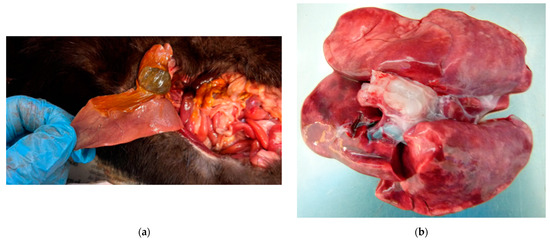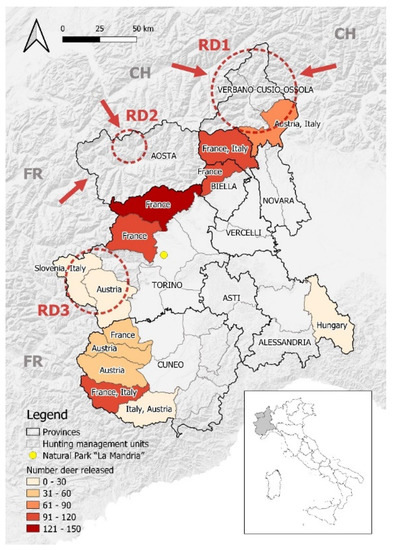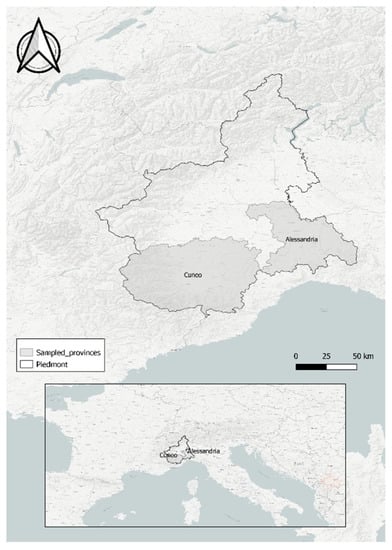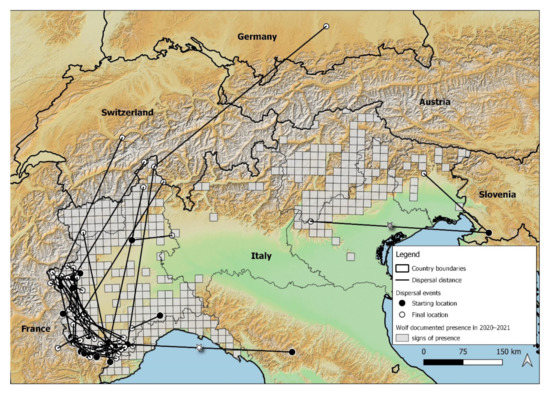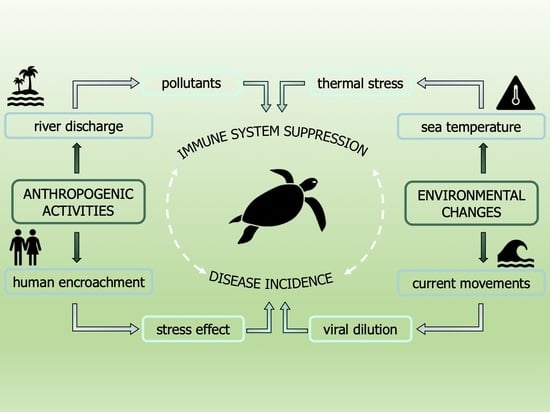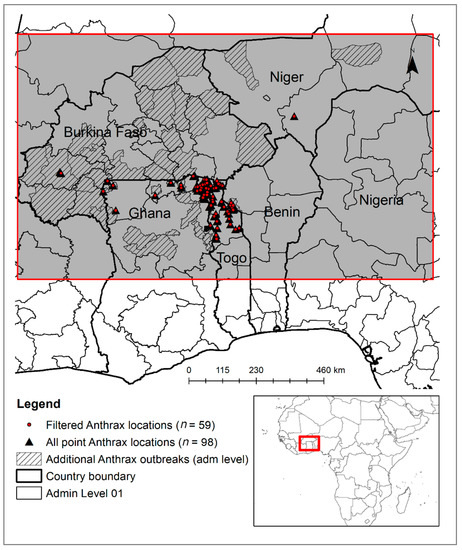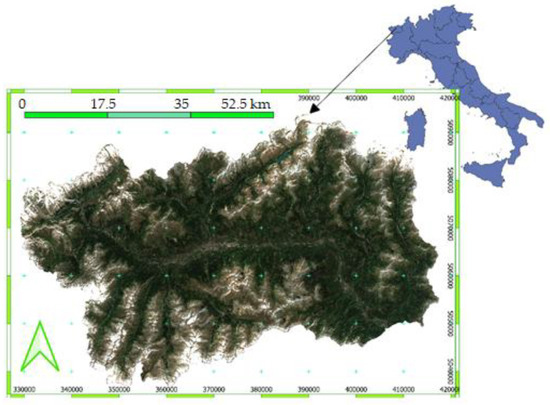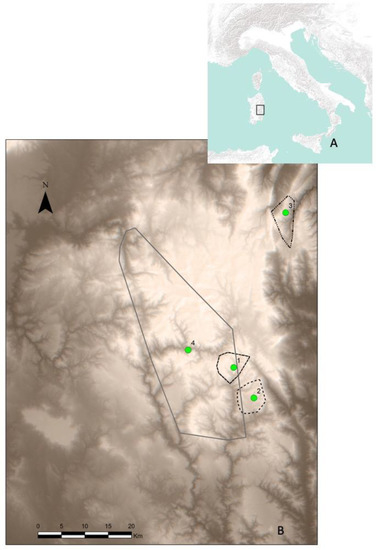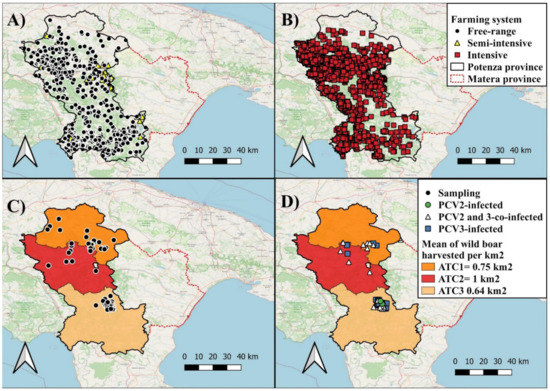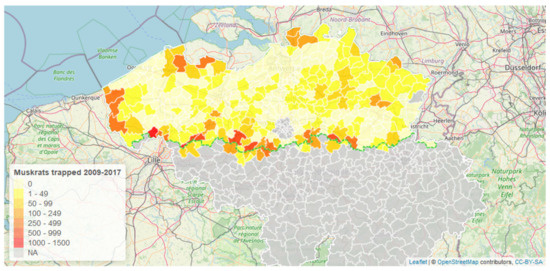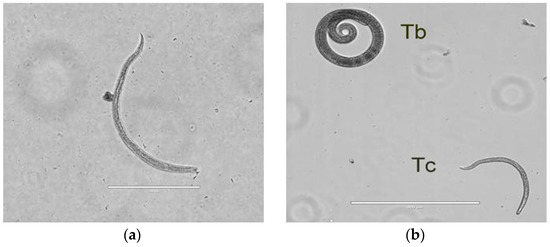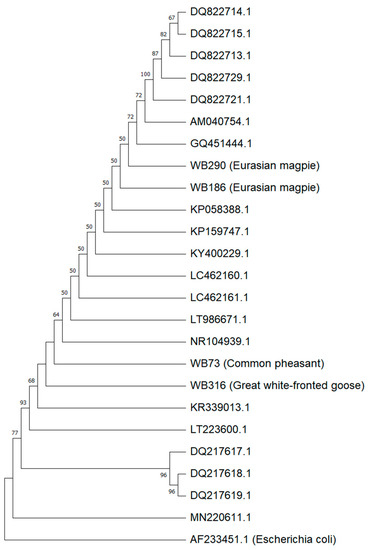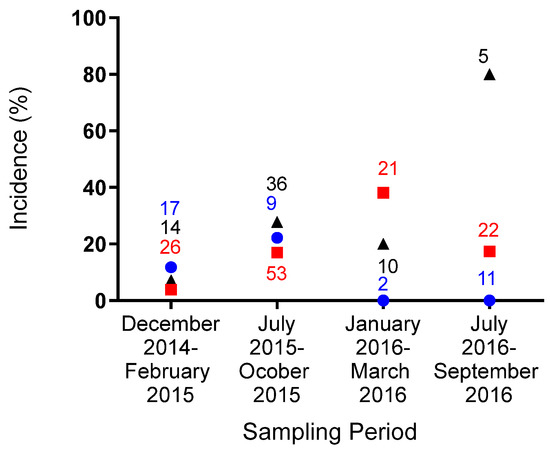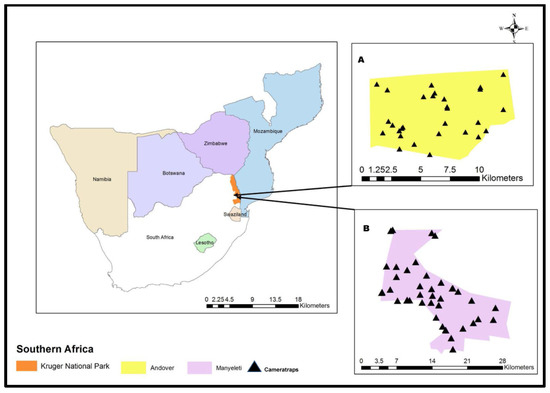Wildlife Disease Ecology and Management
A topical collection in Animals (ISSN 2076-2615). This collection belongs to the section "Wildlife".
Viewed by 43473
Share This Topical Collection
Editors
 Dr. Paolo Tizzani
Dr. Paolo Tizzani
 Dr. Paolo Tizzani
Dr. Paolo Tizzani
E-Mail
Website
Collection Editor
Dipartimento di Scienze Veterinarie, Università di Torino, Largo Paolo Braccini 2, 10095 Grugliasco, Italy
Interests: parasitology; epidemiology; ecopathology; wildlife population health; wildlife management; exotic species; spatial epidemiology
 Dr. Valentina La Morgia
Dr. Valentina La Morgia
 Dr. Valentina La Morgia
Dr. Valentina La Morgia
E-Mail
Website
Collection Editor
Institute for Environmental Protection and Research (ISPRA), via Vitaliano Brancati 48, 00144 Roma/via Ca’ Fornacetta 9, 40064 Ozzano Emilia (BO), Italy
Interests: conservation biology; wildlife management; the management of invasive alien species; the monitoring of species of management and/or conservation concern; analysis of their population dynamics and interactions; spatial and landscape ecology; ecological modeling in general; estimate the abundance of animal populations (Mammals) at broad scales
 Dr. Angela Fanelli
Dr. Angela Fanelli
 Dr. Angela Fanelli
Dr. Angela Fanelli
E-Mail
Website
Collection Editor
Department of Veterinary Medicine, University of Bari “Aldo Moro”, Str. Prov. per Casamassima Km 3, 70010 Valenzano, BA, Italy
Interests: parasitology; wildlife; spatial epidemiology; modeling; zoonoses
Topical Collection Information
Dear Colleagues,
The occurrence and circulation of diseases in wildlife may have several effects on biodiversity conservation, transmission of diseases at the livestock -environmental-wildlife interface, as well as on public health in case of zoonotic pathogens.
Surveillance of diseases in wildlife, joined with the understanding of their dynamics in wild animal populations, is of pivotal importance for the establishment of proper management plans for disease control and prevention.
This collection offers to researchers as well as to wildlife managers the possibility to share relevant studies and experiences related to the study of disease dynamics, ecology and practical actions carried out to reduce the impact of pathogens on animal and public health.
Dr. Paolo Tizzani
Dr. Valentina La Morgia
Dr. Angela Fanelli
Collection Editors
Manuscript Submission Information
Manuscripts should be submitted online at www.mdpi.com by registering and logging in to this website. Once you are registered, click here to go to the submission form. Manuscripts can be submitted until the deadline. All submissions that pass pre-check are peer-reviewed. Accepted papers will be published continuously in the journal (as soon as accepted) and will be listed together on the collection website. Research articles, review articles as well as short communications are invited. For planned papers, a title and short abstract (about 100 words) can be sent to the Editorial Office for announcement on this website.
Submitted manuscripts should not have been published previously, nor be under consideration for publication elsewhere (except conference proceedings papers). All manuscripts are thoroughly refereed through a single-blind peer-review process. A guide for authors and other relevant information for submission of manuscripts is available on the Instructions for Authors page. Animals is an international peer-reviewed open access semimonthly journal published by MDPI.
Please visit the Instructions for Authors page before submitting a manuscript.
The Article Processing Charge (APC) for publication in this open access journal is 2400 CHF (Swiss Francs).
Submitted papers should be well formatted and use good English. Authors may use MDPI's
English editing service prior to publication or during author revisions.
Keywords
- trade
- introduction
- restocking
- exotic parasites
- pathogens
- wildlife movements
Published Papers (17 papers)
Open AccessFeature PaperArticle
Study of Canine Distemper Virus Presence in Catalonia’s Wild Carnivores through H Gene Amplification and Sequencing
by
Junhao Huang, Martí Cortey, Laila Darwich, Jenna Griffin, Elena Obón, Rafael Molina and Margarita Martín
Viewed by 1343
Abstract
Canine distemper virus (CDV) is recognised worldwide as an important pathogen in both domestic and wild carnivores. Few data are available on its impact and spread on the wildlife/wildlife–domestic animal–environment interface. This study, aimed at developing a conservation-oriented control strategy, analysed 89 sick
[...] Read more.
Canine distemper virus (CDV) is recognised worldwide as an important pathogen in both domestic and wild carnivores. Few data are available on its impact and spread on the wildlife/wildlife–domestic animal–environment interface. This study, aimed at developing a conservation-oriented control strategy, analysed 89 sick or deceased animals from 2019 to 2023 at the Wildlife Rehabilitation Centre in Torreferrussa. RT-PCR and sequencing of the partial H gene were used to detect and analyse CDV in tissues. The total positive percentage was 20.22% (18/89), comprising 13 red foxes (44.8%), 4 European badgers (28.6%), and 1 American mink (4.5%), while 24 Eurasian otters tested negative. Phylogenetic analysis indicated that all of the CDV strains belong to the European lineage. Geographically distant individuals and different species shared the same viral strain, suggesting a strong capacity of CDV for interspecies and long-distance transmission. This calls for further research, particularly focusing on potential impacts of CDV on endangered carnivores.
Full article
►▼
Show Figures
Open AccessArticle
Vector-Borne Pathogens in Stray Cats in Eastern Germany (Thuringia)
by
Ingo Schäfer, Axel Peukert, Katharina Kerner and Elisabeth Müller
Cited by 1 | Viewed by 1116
Abstract
Bacterial, protozoal, and viral vector-borne pathogens (VBPs) can cause infections in cats. There is little information on feline VBP prevalence in Germany. Stray cats are frequently exposed to vectors but receive no veterinary care. The aim of this study was to determine the
[...] Read more.
Bacterial, protozoal, and viral vector-borne pathogens (VBPs) can cause infections in cats. There is little information on feline VBP prevalence in Germany. Stray cats are frequently exposed to vectors but receive no veterinary care. The aim of this study was to determine the prevalence of selected VBPs in stray cats. EDTA blood and serum samples were taken from apparently healthy stray cats during a spay/neuter campaign in the federal state of Thuringia. Overall, 11/50 (22%) and 32/50 (64%) cats tested positive for at least one VBP by direct and indirect detection methods, respectively. PCR testing of EDTA blood detected hemotropic
Mycoplasma spp. in 12% of cats,
Hepatozoon spp. in 10%, and
Anaplasma phagocytophilum in 4%. PCR testing for
Rickettsia spp. and piroplasms was negative. IFAT on serum samples showed 46% of cats had detectable antibodies for
Bartonella spp., 30% for
Rickettsia spp., and 16% for
A. phagocytophilum. The cats were additionally tested for feline coronavirus, FIV, and FeLV to identify potential risk factors for pathogen contact and/or infections. No correlation between FIV and FeLV status and VBP positivity was detected.
Anaplasma phagocytophilum,
Rickettsia spp., and
Bartonella spp. have zoonotic potential, and surveillance is recommended in the context of the One Health approach.
Full article
Open AccessCommunication
Unintentional Recovery of Parasitic Diversity Following Restoration of Red Deer (Cervus elaphus) in North-Western Italy
by
Barbara Moroni, Mattia Begovoeva, Luca Rossi, Samer Angelone, Serena Robetto, Luca Visconti, Anna Regis, Roberto Viganò, Nicole Preacco, Simona Zoppi, Luisa Rambozzi and Pier Giuseppe Meneguz
Viewed by 1861
Abstract
Red deer (
Cervus elaphus) populations in north-western Italy have been remodeled in recent decades. Multiple translocations and the spontaneous migration from Switzerland and France resulted in the successful redistribution of the red deer after human-driven extirpation during the 18th century. The
[...] Read more.
Red deer (
Cervus elaphus) populations in north-western Italy have been remodeled in recent decades. Multiple translocations and the spontaneous migration from Switzerland and France resulted in the successful redistribution of the red deer after human-driven extirpation during the 18th century. The scarcely diverse parasitic community harbored by these cervids has been enriched with two species-specific taxa,
Onchocerca jakutensis and
Phayigomyia picta, suggesting that the recovery of parasitic biodiversity could be included amongst future conservation goals of this intensively managed game. Nodular onchocercosis was reported in three red deer populations since 2011, while nasal bots were reported since 2018.
Hypoderma spp. larvae were identified for the first time in 1989, then a second record was made in 2014 in the province of Biella, where a yearling male in poor condition infested with
Hypoderma diana was observed. In the perspective that the restoration of species-specific parasite communities of native mammals in Europe is increasingly perceived as a conservation target, with similar dignity as the conservation of their hosts, baseline data presented in this communication may give new insights for future parasite conservation efforts.
Full article
►▼
Show Figures
Open AccessArticle
Gastrointestinal Parasite Community and Phenotypic Plasticity in Native and Introduced Alien Lagomorpha
by
Stefano Catalano, Valentina La Morgia, Anna Rita Molinar Min, Angela Fanelli, Pier Giuseppe Meneguz and Paolo Tizzani
Cited by 1 | Viewed by 1610
Abstract
The Convention on Biological Diversity classifies “Invasive Alien Species” as those whose introduction and spread represents a threat for biodiversity. Introduction of alien pathogens, including parasites, is one of the main consequences of the introduction of invasive alien species. The objective of this
[...] Read more.
The Convention on Biological Diversity classifies “Invasive Alien Species” as those whose introduction and spread represents a threat for biodiversity. Introduction of alien pathogens, including parasites, is one of the main consequences of the introduction of invasive alien species. The objective of this work was to assess the parasite community composition in native lagomorphs
(Lepus europaeus and
Lepus timidus varronis) in sympatric and non-sympatric conditions with an alien lagomorph (
Sylvilagus floridanus), and to evaluate the phenotypic traits of exotic parasites in such conditions. We firstly describe the characteristics of the parasite community in the different host species (richness, prevalence, abundance and intensity), and, secondly, the phenotypic traits of the observed parasite species in each host. Nine helminths were reported on: eight nematodes (
Obeliscoides cuniculi,
Trichostrongylus calcaratus,
Trichostrongylus retortaeformis,
Trichostrongylus affinis,
Trichuris leporis,
Trichostrongylus colubriformis,
Passalurus ambiguus, and
Nematodirus sp.) and one unidentified cestode. In addition, exotic parasites showed significantly different phenotypic plasticity after spillover from
S. floridanus to
L. europaeus, whereas endemic parasite species were not isolated in the alien
S. floridanus. Our results highlight that the community of autochthonous and allochthonous Lagomorpha in northwestern Italy represents an extremely interesting system for modelling ecological and evolutionary interactions between parasites and their hosts.
Full article
►▼
Show Figures
Open AccessArticle
Wolf Dispersal Patterns in the Italian Alps and Implications for Wildlife Diseases Spreading
by
Francesca Marucco, Kristine L. Pilgrim, Elisa Avanzinelli, Michael K. Schwartz and Luca Rossi
Cited by 9 | Viewed by 3410
Abstract
Wildlife dispersal directly influences population expansion patterns, and may have indirect effects on the spread of wildlife diseases. Despite its importance to conservation, little is known about dispersal for several species. Dispersal processes in expanding wolf (
Canis lupus) populations in Europe
[...] Read more.
Wildlife dispersal directly influences population expansion patterns, and may have indirect effects on the spread of wildlife diseases. Despite its importance to conservation, little is known about dispersal for several species. Dispersal processes in expanding wolf (
Canis lupus) populations in Europe is not well documented. Documenting the natural dispersal pattern of the expanding wolf population in the Alps might help understanding the overall population dynamics and identifying diseases that might be connected with the process. We documented 55 natural dispersal events of the expanding Italian wolf alpine population over a 20-year period through the use of non-invasive genetic sampling. We examined a 16-locus microsatellite DNA dataset of 2857 wolf samples mainly collected in the Western Alps. From this, we identified 915 individuals, recaptured 387 (42.3%) of individuals, documenting 55 dispersal events. On average, the minimum straight dispersal distance was 65.8 km (±67.7 km), from 7.7 km to 517.2 km. We discussed the potential implications for maintaining genetic diversity of the population and for wildlife diseases spreading.
Full article
►▼
Show Figures
Open AccessArticle
Occurrence of Fibropapillomatosis in Green Turtles (Chelonia mydas) in Relation to Environmental Changes in Coastal Ecosystems in Texas and Florida: A Retrospective Study
by
Costanza Manes, Daniele Pinton, Alberto Canestrelli and Ilaria Capua
Cited by 7 | Viewed by 4516
Abstract
Fibropapillomatosis is a neoplastic disease of marine turtles, with green turtles (
Chelonia mydas) being the most affected species. Fibropapillomatosis causes debilitating tumor growths on soft tissues and internal organs, often with lethal consequences. Disease incidence has been increasing in the last
[...] Read more.
Fibropapillomatosis is a neoplastic disease of marine turtles, with green turtles (
Chelonia mydas) being the most affected species. Fibropapillomatosis causes debilitating tumor growths on soft tissues and internal organs, often with lethal consequences. Disease incidence has been increasing in the last few decades and the reason is still uncertain. The potential viral infectious agent of Fibropapillomatosis, chelonid herpesvirus 5, has been co-evolving with its sea turtle host for millions of years and no major mutation linked with increased disease occurrence has been detected. Hence, frequent outbreaks in recent decades are likely attributable to external drivers such as large-scale anthropogenic changes in the green turtle coastal marine ecosystem. This study found that variations in sea surface temperature, salinity, and nutrient effluent discharge from nearby rivers were correlated with an increased incidence of the disease, substantiating that these may be among the significant environmental drivers impacting Fibropapillomatosis prevalence. This study offers data and insight on the need to establish a baseline of environmental factors which may drive Fibropapillomatosis and its clinical exacerbation. We highlight the multifactorial nature of this disease and support the inclusion of interdisciplinary work in future Fibropapillomatosis research efforts.
Full article
►▼
Show Figures
Open AccessArticle
Seasonality and Ecological Suitability Modelling for Anthrax (Bacillus anthracis) in Western Africa
by
Claudia Pittiglio, Sean Shadomy, Ahmed El Idrissi, Baba Soumare, Juan Lubroth and Yilma Makonnen
Cited by 10 | Viewed by 2999
Abstract
Anthrax is hyper-endemic in West Africa affecting wildlife, livestock and humans. Prediction is difficult due to the lack of accurate outbreak data. However, predicting the risk of infection is important for public health, wildlife conservation and livestock economies. In this study, the seasonality
[...] Read more.
Anthrax is hyper-endemic in West Africa affecting wildlife, livestock and humans. Prediction is difficult due to the lack of accurate outbreak data. However, predicting the risk of infection is important for public health, wildlife conservation and livestock economies. In this study, the seasonality of anthrax outbreaks in West Africa was investigated using climate time series and ecological niche modeling to identify environmental factors related to anthrax occurrence, develop geospatial risk maps and identify seasonal patterns. Outbreak data in livestock, wildlife and humans between 2010 and 2018 were compiled from different sources and analyzed against monthly rates of change in precipitation, normalized difference vegetation index (NDVI) and land surface temperature. Maximum Entropy was used to predict and map the environmental suitability of anthrax occurrence. The findings showed that: (i) Anthrax outbreaks significantly (99%) increased with incremental changes in monthly precipitation and vegetation growth and decremental changes in monthly temperature during January–June. This explains the occurrence of the anthrax peak during the early wet season in West Africa. (ii) Livestock density, precipitation seasonality, NDVI and alkaline soils were the main predictors of anthrax suitability. (iii) Our approach optimized the use of limited and heterogeneous datasets and ecological niche modeling, demonstrating the value of integrated disease notification data and outbreak reports to generate risk maps. Our findings can inform public, animal and environmental health and enhance national and regional One Health disease control strategies.
Full article
►▼
Show Figures
Open AccessArticle
An Integrated, Tentative Remote-Sensing Approach Based on NDVI Entropy to Model Canine Distemper Virus in Wildlife and to Prompt Science-Based Management Policies
by
Emanuele Carella, Tommaso Orusa, Annalisa Viani, Daniela Meloni, Enrico Borgogno-Mondino and Riccardo Orusa
Cited by 29 | Viewed by 2980
Abstract
Changes in land use and land cover as well as feedback on the climate deeply affect the landscape worldwide. This phenomenon has also enlarged the human–wildlife interface and amplified the risk of potential new zoonoses. The expansion of the human settlement is supposed
[...] Read more.
Changes in land use and land cover as well as feedback on the climate deeply affect the landscape worldwide. This phenomenon has also enlarged the human–wildlife interface and amplified the risk of potential new zoonoses. The expansion of the human settlement is supposed to affect the spread and distribution of wildlife diseases such as canine distemper virus (CDV), by shaping the distribution, density, and movements of wildlife. Nevertheless, there is very little evidence in the scientific literature on how remote sensing and GIS tools may help the veterinary sector to better monitor the spread of CDV in wildlife and to enforce ecological studies and new management policies in the near future. Thus, we perform a study in Northwestern Italy (Aosta Valley Autonomous Region), focusing on the relative epidemic waves of CDV that cause a virulent disease infecting different animal species with high host mortality. CDV has been detected in several mammalian from Canidae, Mustelidae, Procyonidae, Ursidae, and Viverridae families. In this study, the prevalence is determined at 60% in red fox (
Vulpes vulpes,
n = 296), 14% in wolf (
Canis lupus,
n = 157), 47% in badger (
Meles meles,
n = 103), and 51% in beech marten (
Martes foina,
n = 51). The detection of CDV is performed by means of real-time PCR. All the analyses are done using the TaqMan approach, targeting the chromosomal gene for phosphoprotein, gene P, that is involved in the transcription and replication of the virus. By adopting Earth Observation Data, we notice that CDV trends are strongly related to an altitude gradient and NDVI entropy changes through the years. A tentative model is developed concerning the ground data collected in the Aosta Valley region. According to our preliminary study, entropy computed from remote-sensing data can represent a valuable tool to monitor CDV spread as a proxy data predictor of the intensity of fragmentation of a given landscape and therefore also to monitor CDV. In conclusion, the evaluation from space of the landscape variations regarding the wildlife ecological corridors due to anthropic or natural disturbances may assist veterinarians and wildlife ecologists to enforce management health policies in a One Health perspective by pointing out the time and spatial conditions of interaction between wildlife. Surveillance and disease control actions are supposed to be carried out to strengthen the usage of geospatial analysis tools and techniques. These tools and techniques can deeply assist in better understanding and monitoring diseases affecting wildlife thanks to an integrated management approach.
Full article
►▼
Show Figures
Open AccessArticle
Reintroductions of the Corsican Red Deer (Cervus elaphus corsicanus): Conservation Projects and Sanitary Risk
by
Francesco Riga, Luciano Mandas, Nicola Putzu and Andrea Murgia
Cited by 3 | Viewed by 2107
Abstract
The Corsican red deer is an endangered subspecies that needs artificial translocation projects to gain its complete recovery with the formation of viable, interconnected populations. Between 2007 and 2017, we performed two reintroduction projects in four sites in central–eastern Sardinia via tracking 32
[...] Read more.
The Corsican red deer is an endangered subspecies that needs artificial translocation projects to gain its complete recovery with the formation of viable, interconnected populations. Between 2007 and 2017, we performed two reintroduction projects in four sites in central–eastern Sardinia via tracking 32 deer by means of GPS/GSM radiotelemetry. On the basis of the obtained results, we built a species distribution model (SDM) using MaxEnt software, selecting 200 random points from the merged deer core areas as presence data. Furthermore, to evaluate the sanitary risk linked to artificial translocations, we analyzed deer positivity to Bluetongue virus (BTV) in the founder populations. The SDM showed a high deer capability to colonize central–eastern Sardinia, but it also showed the possibility of spreading BTV to domestic sheep because sanitary analyses confirmed the virus’ presence in the founder populations. Our main conclusion was that reintroductions are effective tools for the long-term conservation of the Corsican red deer, as long as sanitary risks are minimized by means of sanitary monitoring of translocated deer.
Full article
►▼
Show Figures
Open AccessArticle
Genetic Diversity of Porcine Circovirus Types 2 and 3 in Wild Boar in Italy
by
Angela Fanelli, Francesco Pellegrini, Michele Camero, Cristiana Catella, Domenico Buonavoglia, Giovanna Fusco, Vito Martella and Gianvito Lanave
Cited by 9 | Viewed by 1762
Abstract
Porcine circovirus (PCV) infection is associated with relevant economic impact to the pig industry. To date, four species of PCV (PCV1 to 4) have been identified but only PCV2 has been associated firmly with disease in pigs. The objective of this study was
[...] Read more.
Porcine circovirus (PCV) infection is associated with relevant economic impact to the pig industry. To date, four species of PCV (PCV1 to 4) have been identified but only PCV2 has been associated firmly with disease in pigs. The objective of this study was to assess the prevalence of PCV2 and PCV3 in the wild boar population in Basilicata region, Southern Italy, since this region is characterized by large forested and rural areas and the anthropic pressure is lower than in other Italian regions. Liver samples from 82 hunted wild boar were collected in 2021 from 3 different hunting districts. Sixty (73%, 95%CI: 63–82) samples tested positive for PCVs by quantitative PCR. In detail, 22 (27%, 95%CI: 18–37) were positive for PCV2, 58 (71%, 95%CI: 60–79) for PCV3, and 20 (24.4%, 95%CI 16–35) for both PCV2 and PCV3. On genome sequencing, different types and sub-types of PCV2 and PCV3 were identified, remarking a genetic diversity and hinting to a global circulation for the identified PCV strains. Overall, the high prevalence suggests that PCV2 and PCV3 infections are endemic in the wild boar population, posing risks for semi-intensive and free-range pig farming, typical of this region, due to contact with PCV-infected wild boar.
Full article
►▼
Show Figures
Open AccessArticle
Prevalence of Fox Tapeworm in Invasive Muskrats in Flanders (North Belgium)
by
Emma Cartuyvels, Tim Adriaens, Kristof Baert, Frank Huysentruyt and Koen Van Den Berge
Cited by 1 | Viewed by 2112
Abstract
One way in which invasive alien species affect their environment is by acting as pathogen hosts. Pathogens limited by the availability of the native host species can profit from the presence of additional hosts. The muskrat (
Ondatra zibethicus) is known to
[...] Read more.
One way in which invasive alien species affect their environment is by acting as pathogen hosts. Pathogens limited by the availability of the native host species can profit from the presence of additional hosts. The muskrat (
Ondatra zibethicus) is known to act as an intermediate host for the fox tapeworm (
Echinococcus multilocularis). From 2009 to 2017, 15,402 muskrats caught in Flanders and across the border with Wallonia and France were collected and dissected with the aim of understanding the prevalence of this parasite in muskrats. Visual examination of the livers revealed 202 infected animals (1.31%). Out of the 9421 animals caught in Flanders, we found 82 individuals (0.87%) infected with
E. multilocularis. No increase in prevalence was observed during this study. All of the infected animals in Flanders were found in municipalities along the Walloon border. We did not observe a northward spread of
E. multilocularis infection from Wallonia to Flanders. We hypothesise that the low prevalence is the result of the reduced availability of intermediate hosts and the successful control programme which is keeping muskrat densities in the centre of the region at low levels and is preventing influx from other areas. Our results illustrate that muskrats are good sentinels for
E. multilocularis and regular screening can gain valuable insight into the spread of this zoonosis.
Full article
►▼
Show Figures
Open AccessArticle
Detection of Chlamydial DNA from Mediterranean Loggerhead Sea Turtles in Southern Italy
by
Antonino Pace, Nadia Vicari, Sara Rigamonti, Simone Magnino, Luca Borrelli, Ludovico Dipineto, Alessandro Fioretti, Sandra Hochscheid, Luís Tavares and Ana Duarte
Cited by 3 | Viewed by 1939
Abstract
Chlamydiae are obligate intracellular bacteria that include pathogens of human and veterinary importance. Several reptiles were reported to host chlamydial agents, but pathogenicity in these animals still needs clarification. Given that only one report of chlamydiosis was described in sea turtles, and that
[...] Read more.
Chlamydiae are obligate intracellular bacteria that include pathogens of human and veterinary importance. Several reptiles were reported to host chlamydial agents, but pathogenicity in these animals still needs clarification. Given that only one report of chlamydiosis was described in sea turtles, and that chlamydiae might also be detected in hosts without clinical signs, the current study examined asymptomatic Mediterranean loggerhead sea turtles for the presence of chlamydial DNA. Twenty loggerhead sea turtles, rehabilitated at the Marine Turtle Research Centre (Portici, Italy), were examined collecting ocular-conjunctival, oropharyngeal and nasal swabs. Samples were processed through quantitative and conventional PCR analyses to identify Chlamydiales and
Chlamydiaceae, with particular attention to
C. pecorum,
C. pneumoniae,
C. psittaci, and
C. trachomatis. Although it was not possible to determine the species of chlamydiae involved, the detection of chlamydial DNA from the collected samples suggests that these microorganisms might act as opportunistic pathogens, and underlines the role of sea turtles as potential carriers. This study highlights the presence of chlamydial agents in sea turtles, and encourages further research to fully characterize these microorganisms, in order to improve the management of the health and conservation of these endangered species, and prevent potential zoonotic implications.
Full article
Open AccessCommunication
Detection of Toxocara cati Larvae in a Common Buzzard (Buteo buteo) and in a Red Kite (Milvus milvus) in Basilicata Region, Italy
by
Mariateresa Toce, Antonella Cristina Romano, Ileana Pietragalla, Gianluca Marucci and Lucia Palazzo
Viewed by 1875
Abstract
Toxocara cati is a common parasite of wild and domestic felines, and presents a cosmopolitan distribution. Adult parasites localize in the gut of the definitive host giving rise to the infection, which usually runs asymptomatic. These worms produce eggs that are excreted with
[...] Read more.
Toxocara cati is a common parasite of wild and domestic felines, and presents a cosmopolitan distribution. Adult parasites localize in the gut of the definitive host giving rise to the infection, which usually runs asymptomatic. These worms produce eggs that are excreted with feces into the environment, where they become a source of infection for paratenic hosts, such as mammals, birds, and invertebrates. In this brief communication, we report the detection of
T. cati larvae in a common buzzard (
Buteo buteo) and a red kite (
Milvus milvus), in the Basilicata Region of Italy. This result may be important to define new pathways of spread and survival of
T. cati in the wild.
Full article
►▼
Show Figures
Open AccessCommentary
African Swine Fever—How to Unravel Fake News in Veterinary Medicine
by
Adriana Trotta, Mariarosaria Marinaro, Alessandra Cavalli, Marco Cordisco, Angela Piperis, Canio Buonavoglia and Marialaura Corrente
Cited by 3 | Viewed by 3328
Abstract
In recent years, fake scientific news has spread much faster through the Internet and social media within the so-called “infodemic”. African Swine Fever (ASF) is a perfect case study to prove how fake news can undermine the public health response, even in the
[...] Read more.
In recent years, fake scientific news has spread much faster through the Internet and social media within the so-called “infodemic”. African Swine Fever (ASF) is a perfect case study to prove how fake news can undermine the public health response, even in the veterinary field. ASF is a highly contagious infective disease affecting exclusively domestic and wild pigs such as wild boars. ASF can cause social damage and economic losses both directly (due to the high mortality rate) and indirectly (due to international sanctions). Although ASF is not a threat to human health, since 2018 newspapers have often reported false or misleading news, ranging from misinterpreted findings/data to fake or alarmistic news. In some cases, fake news was spread, such as the use of snipers at the border of nations to kill wild boars, or those reports concerning possible risks to human health. In order to provide real and fact-based news on epidemics, some organizations have created easy-to-read infographic and iconographic materials, available on their websites, to help the readers identifying the fake news. Indeed, it is crucial that governments and scientific organizations work against fear and anxiety, using simple and clear communication.
Full article
Open AccessCommunication
ESBL-Producing Moellerella wisconsensis—The Contribution of Wild Birds in the Dissemination of a Zoonotic Pathogen
by
Zoi Athanasakopoulou, Marina Sofia, Alexios Giannakopoulos, Konstantinos Papageorgiou, Dimitris C. Chatzopoulos, Vassiliki Spyrou, Evanthia Petridou, Efthymia Petinaki and Charalambos Billinis
Cited by 5 | Viewed by 2762
Abstract
Moellerella wisconsensis is an Enterobacteriaceae with unclarified dispersion and pathogenicity. During an ongoing investigation about antimicrobial resistance in Greece, the occurrence of
M. wisconsensis was evaluated among wild birds and humans. A total of 445 wild bird and 2000 human fecal samples were
[...] Read more.
Moellerella wisconsensis is an Enterobacteriaceae with unclarified dispersion and pathogenicity. During an ongoing investigation about antimicrobial resistance in Greece, the occurrence of
M. wisconsensis was evaluated among wild birds and humans. A total of 445 wild bird and 2000 human fecal samples were collected and screened for the presence of the organism. Subsequently, all
M. wisconsensis strains were phenotypically and molecularly characterized regarding their antimicrobial resistance characteristics. Four
M. wisconsensis were isolated from a common pheasant (
Phasianus colchicus), two Eurasian magpies (
Pica pica) and a great white-fronted goose (
Anser albifrons). Among these four strains, the three latter presented resistance to 3rd generation cephalosporins, were phenotypically confirmed to produce ESBLs and were found to harbor
blaCTX-M-1. The three ESBL isolates additionally exhibited resistance to tetracyclines, while resistance to aminoglycosides was detected in two of them and to trimethoprim/sulfamethoxazole in one. No
Moellerella wisconsensis strains were retrieved from the human samples tested. This is the first report that provides evidence of
M. wisconsensis dissemination among wild birds in Greece, describing CTX-M-1 production in multidrug resistant wild birds’ isolates of this bacterial species.
Full article
►▼
Show Figures
Open AccessArticle
Trait-Based Vaccination of Individual Meerkats (Suricata suricatta) against Tuberculosis Provides Evidence to Support Targeted Disease Control
by
Stuart J. Patterson, Tim H. Clutton-Brock, Dirk U. Pfeiffer and Julian A. Drewe
Cited by 1 | Viewed by 2084
Abstract
Individuals vary in their potential to acquire and transmit infections, but this fact is currently underexploited in disease control strategies. We trialled a trait-based vaccination strategy to reduce tuberculosis in free-living meerkats by targeting high-contact meerkats (socially dominant individuals) in one study arm,
[...] Read more.
Individuals vary in their potential to acquire and transmit infections, but this fact is currently underexploited in disease control strategies. We trialled a trait-based vaccination strategy to reduce tuberculosis in free-living meerkats by targeting high-contact meerkats (socially dominant individuals) in one study arm, and high-susceptibility individuals (young subordinates) in a second arm. We monitored infection within vaccinated groups over two years comparing the results with untreated control groups. Being a member of a high-contact group had a protective effect on individuals’ survival times (Hazard Ratio = 0.5, 95% Confidence Interval, CI: 0.29–0.88,
p = 0.02) compared to control groups. Over the study, odds of testing positive for tuberculosis increased more than five-fold in control groups (Odds Ratio = 5.40, 95% CI = 0.94–30.98,
p = 0.058); however, no increases were observed in either of the treatment arms. Targeted disease control approaches, such as the one described in this study, allow for reduced numbers of interventions. Here, trait-based vaccination was associated with reduced infection rates and thus has the potential to offer more efficient alternatives to traditional mass-vaccination policies. Such improvements in efficiency warrant further study and could make infectious disease control more practically achievable in both animal (particularly wildlife) and human populations.
Full article
►▼
Show Figures
Open AccessArticle
Carnivore Detection at the Domestic/Wildlife Interface within Mpumalanga Province, South Africa
by
Jeanette Wentzel, Cory Gall, Mark Bourn, Juan De Beer, Ferreira du Plessis and Geoffrey T. Fosgate
Cited by 1 | Viewed by 3047
Abstract
South African protected areas account for 8% of the total landmass according to World Bank indicators. Effective conservation of biodiversity in protected areas requires the development of specific reserve management objectives addressing species and disease management. The primary objective of the current study
[...] Read more.
South African protected areas account for 8% of the total landmass according to World Bank indicators. Effective conservation of biodiversity in protected areas requires the development of specific reserve management objectives addressing species and disease management. The primary objective of the current study was to identify predictors of carnivore detection in an effort to inform carnivore species management plans on Andover and Manyeleti nature reserves in South Africa. A limited number of camera traps were placed randomly using a grid system. Species detection data were analysed using mixed-effects logistic regression and Spearman’s correlation coefficients. Deterministic inverse distance weighted distribution maps were used to describe the spatial distribution of carnivore species. Camera traps identified similar species as traditional call-up surveys during the study and would be useful as an adjunct census method. Carnivore detection was associated with several variables, including the presence of specific prey species. The measured intra-and interspecies interactions suggested the risk of disease transmission among species, and vaccination for prevalent diseases should be considered to manage this risk.
Full article
►▼
Show Figures







